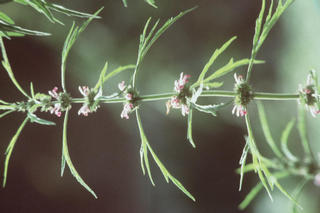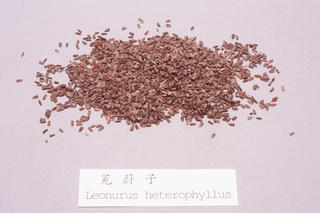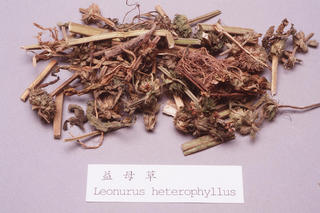Leonurus heterophyllus
Contents
Nomenclature
Other Names:
Historical Use of Leonurus heterophyllus
Leonurus heterophyllus in Traditional Chinese Medicine
Background
Chinese Name (pinyin): Chongweizi
Chinese Name :
Common Name :Motherwort fruit
Specific Name : Fructus leonuri
Scientific Name:
Collection : The aerial parts of the plant is cut down in autumn when the fruit is ripe and dried. The fruit is tapped out and remove from foreign matter.
Description : Trihedral, 2 - 3mm long, about 1.5mm wide. Externally greyish brown with dark colored maculates, slightly broad and truncate at one end, gradually narrowed to be obtuse at the other end. Pericarp thin, cotyledons almost white, oily, odorless and taste bitter.
Identification : Powder: yellowish brown to deep brown. Cells of exocarp slightly radially elongated in transverse sectional view, variable in length, forming numerous raised ridges with yellow reticulated, unlignified cells, subpolygonal in surface view, striated-cuticulate, reticulated cells with striated thickened walls. Sclerenchymatous cells of endocarp slightly tangentially elongated in transverse sectional view, the borders of the cells less distinct with extremely thickened inner walls but the outer walls relatively thin, eccentric lumina containing prisms of calcium oxalate. Stellate in surface view or borders of cells indistinct, prisms obviously visible. Cells of mesocarp subpolygonal in surface view with thin and sinuous walls. Epidermal cells of testa subsquare with slightly thickened and sinuous walls, lumina containing pale yellowish contents. Cells of endosperm containing fixed oil droplets and aleurone grains.Total ash: not more than 10.0%
Processing : Eliminate foreign matter, wash and dry.Stir fried: stir fry as described under the method for simple stir frying (Appendix ll D) until it cracks.
Action : To activate blood circulation and regulate menstruation, to subdue hyperactivity of the liver, and to clear the eye of opacity.
Indication : menstrual disorders, amenorrhea, dysmenorrhea, inflammation of the eye with formation of corneal opacity; dizziness and headache
Precautions : Used with caution for pupil dilation.
Dosage : 4.5 to 9 g.
Storage : Preserve in a ventilated and dry place.
Nomenclature
Other Names:
Historical Use of Leonurus heterophyllus
Leonurus heterophyllus in Traditional Chinese Medicine
Background
Kuncao À¤²Ý
Chinese Name (pinyin): Yimucao
Chinese Name :
Common Name :Motherwort Herb
Specific Name : Herba leonuri
Scientific Name:
Collection : The drug is collected in summer when the foliage branch growing luxuriantly before or at the beginning of the flowering, dried in the sun or dried after cutting into sections.
Description : stem square, frequently branched at the upper part, furrowed longitudinally on 4 sides, 30 - 60cm long, about 0.5cm diameter, externally greyish green or yellowish green, light, texture pliable, fracture medullated in the center. Leaves opposite, petioled, lamina greyish green, mostly crumpled and broken, easily fallen off when whole, the lower leaves palmately ternate, the upper leaves pinnatipartite or pinnatilobately ternate, lobes entire or slightly serrate. Verticillaster axillary, florets pale purple, calyx tubular, corolla bilabiated. Cutting sections about 2cm long. Odour slight, taste slightly bitter.Identification:
Identification : 1.Transverse section of stem: epidermal cells covered with cuticle at the outer walls, pubescent, glandular scales with 4 - 6 or 8 celled head and a unicellular stalk, non-glandular hairs, 1 - 4 celled. Hypodermal collenchyma cells abundant in the angular region. Cortex consisting of several layers of parenchymatous cells. Endodermis distinct, pericyclic fibre bundles slightly lignified. Phloem relatively narrow. Cambium indistinct, xylem well developed in the angular region. Pith parenchymatous cells relatively large. Parenchymatous cells containing minute needle crystals of calcium oxalate and small prisms.2.To 3g of the powder add 30ml of ethanol, heat under reflux for 1 hour, allow to cool, filter and concentrate the filtrate to 5ml. Apply the concentrate to an activated charcoal aluminum oxide column of 10mm in internal diameter packed with 0.5g of activated charcoal, 2g of neutral aluminum oxide (100 - 120 mesh), eluate with 30 ml of ethanol and evaporate the eluate to dryness. Dissolve the residue in 0.5ml of ethanol, use as the test solution. To stachydrine hydrochloric CRS add ethanol to produced a solution containing 5mg per ml as the reference solution. Carry out the method for thin layer chromatography (Appendix Vl B) using silica gel G as the coating substance and n-butanol-hydrochloric acid-water (4:1:0.5) as the mobile phase. Apply separately to the plate 10µl of each of the two solutions. After developing and removal of the plate, dry it in the air, and spray with dilute potassium iodobismuthate TS. The spot in the chromatogram obtained with test solution corresponds in position and colour to the spot in the chromatogram obtained with the reference solution.Assay: Reference preparation: Dissolve 25mg, accurately weighed of stachydrine hydrochloride CRS previously dried to constant weight at 105ºC, in a 25ml volumetric flask with hydrochloric acid solution (0.1mol/L) and dilute to volume, shake thoroughly (1mg of stachydrine hydroxide per ml)Test preparation: To about 3g of the powder ( through no. 3 sieve), accurately weighed (perform a determination of water (Appendix lx H, method 1) in a stoppered conical flask, add 50ml of ethanol, accurately measured. Ultrasonicate for 30 minutes (power 350W, frequency 35kHz) and filter. Discard the initial filtrate, transfer 25ml of the successive filtrate, accurately measured to a 100ml beaker, evaporate to dryness on a water bath, dissolve theresidue in exactly 10ml of hydrochloric acid solution ( 0.1mol/L). Add 0.5g of activated charcoal, heat on a water bath for 30 seconds, stir well and filter. Transfer the filtrate to a 25ml volumetric flask, wash the beaker and the filter funnel with 10ml of 0.1mol/L hydrochloric acid solution in portions. Combine the washings to the flask and dilute to volume.Procedure: Measure accurately 10ml of each of the reference solution, the test solution and 20ml of hydrochloric acid solution (0.1mol/L, as blank) separate to 25ml of freshly prepared 2% ammonium reineckate solution, accurately measured, mix well and dilute to volume with hydrochloric acid solution (0.1mol/L). Mix well, allow to stand in an ice bath for 1 hour, filter through a dry filter paper, discard the initial filtrate. Carry out the method for spectrophotometry Appendix V B), measure the absorbance of the successive filtrate at 525nm, subtract the absorbance of the reference preparation (or the teat preparation) from the absorbance of blank and calculate the content of alkaloids. It contains not less then 0.40% of alkaloids, calculated as stachydrine hydrochloride on the dried basis.
Processing : Eliminate foreign matter, wash clean rapidly, soften thoroughly, cut into sections and dry.
Action : To regulate menstruation by activating blood circulation, and to induce diuresis.
Indication : menstrual disorders, dysmenorrhea, amenorrhea, incessant dripping of lochia; edema and oliguria such as edema in acute nephritis
Precautions : Contraindicated in pregnancy.
Dosage : 9 to 30 g.
Storage : Preserve in a dry place.
Synonymns for Leonurus heterophyllus
Patent Medicines and Medicines with Multiple Ingredients that include Leonurus heterophyllus
Pharmaceutical Information
Chemical Constituents
Evidence or the Use of Leonurus heterophyllus in the Treatment of Epilepesy
Basic Science
Animal Studies
Cohort, Case-Control and Non-Randomized Trials
Randomized Controlled Trials
Meta-Analysis
1st Five Results: pubmed search
Fu-Chao Liu, Huang-Ping Yu, Hung-Chen Lee, Chun-Yu Chen, Chia-Chih Liao
The Modulation of Phospho-Extracellular Signal-Regulated Kinase and Phospho-Protein Kinase B Signaling Pathways plus Activity of Macrophage-Stimulating Protein Contribute to the Protective Effect of Stachydrine on Acetaminophen-Induced Liver Injury.
Int J Mol Sci: 2024, 25(3);
[PubMed:38338766]
[WorldCat.org]
[DOI]
(I e)
Xiao-Na Ma, Wei Feng, Nan Li, Shu-Lin Chen, Xiao-Qin Zhong, Jia-Xu Chen, Chang-Song Lin, Qiang Xu
Leonurine alleviates rheumatoid arthritis by regulating the Hippo signaling pathway.
Phytomedicine: 2024, 123;155243
[PubMed:38056147]
[WorldCat.org]
[DOI]
(I p)
Xi Zhu, Yingbiao Wu, Xiaogang Zhang, Wei Gu, Zhongping Ning
Stachydrine ameliorates hypoxia reoxygenation injury of cardiomyocyte via enhancing SIRT1-Nrf2 pathway.
J Cardiothorac Surg: 2023, 18(1);265
[PubMed:37752609]
[WorldCat.org]
[DOI]
(I e)
Jiewei Yu, Lingling Ke, Jingjing Zhou, Chunyan Ding, Hui Yang, Dongbiao Yan, Chengbi Yu
Stachydrine Relieved the Inflammation and Promoted the Autophagy in Diabetes Retinopathy Through Activating the AMPK/SIRT1 Signaling Pathway.
Diabetes Metab Syndr Obes: 2023, 16;2593-2604
[PubMed:37649589]
[WorldCat.org]
[DOI]
(P e)
T W Jung, H Kim, S Y Park, W Cho, H Oh, H J Lee, A M Abd El-Aty, A Hacimuftuoglu, J H Jeong
Stachydrine alleviates lipid-induced skeletal muscle insulin resistance via AMPK/HO-1-mediated suppression of inflammation and endoplasmic reticulum stress.
J Endocrinol Invest: 2022, 45(11);2181-2191
[PubMed:35834165]
[WorldCat.org]
[DOI]
(I p)


